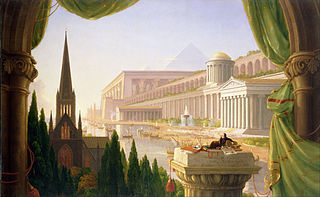 W
WThe Aqueduct at Marly is an 1874 painting by Alfred Sisley. It was bought from the artist by Paul Durand-Ruel in 1876 before being acquired by Edward Libbey, who in turn donated it to the Toledo Museum of Art, where it now hangs. It shows the Aqueduc de Louveciennes. A lifesize reproduction of it is sited at the site of its creation as part of the Pays des Impressionnistes scheme.
 W
WThe Architect's Dream is an 1840 oil painting created by Thomas Cole for New York architect Ithiel Town. Cole incorporated pieces of architecture from Egyptian, Greek, Roman, and Gothic styles in various different parts of the painting, having dabbled in architecture previously. Cole finished the painting in only five weeks and showed it in the National Academy of Design annual exhibition that year. However, the painting was not well received by Town, who refused to accept the painting because he claimed that it was "exclusively architectural".
 W
WBlind Man's Bluff is a painting by the French Rococo painter Jean-Honoré Fragonard, produced around 1750 in oil on canvas. It is held by the Toledo Museum of Art in Toledo, Ohio, United States, which purchased it with funds from the Libbey Endowment, a gift of the glass manufacturer Edward Libbey who founded the museum in 1901.
 W
WChildren in a Chariot is a 1779 painting by Francisco de Goya. It is part of the third series of cartoons he produced for tapestries at the Royal Palace of El Pardo; the tapestry in question was to be positioned over a door. The painting is in the Toledo Museum of Art.
 W
WThe Crowning of Saint Catherine is an oil on canvas painting by Peter Paul Rubens, now in the Toledo Museum of Art. It portrays Catherine of Alexandria, an early 4th century martyr.
 W
WEntrance to the Grand Canal, Venice is a 1905 oil on canvas painting by Paul Signac, now in the Toledo Museum of Art, Ohio, USA. It shows the entrance to the Grand Canal in Venice, with the Dogana da Mar and Santa Maria della Salute in the background.
 W
WHouses at Auvers is an oil painting by Vincent van Gogh, painted towards the end of May or beginning of June 1890, shortly after he had moved to Auvers-sur-Oise, a small town northwest of Paris, France.
 W
WLot and His Daughters is a 1635-1638 painting by Artemisia Gentileschi, now in the Toledo Museum of Art.. The painting has only recently been attributed to Gentileschi. It was first purchased by the Toldeo Museum of Art as a work of Bernardo Cavallini. Domenico Gargiulo has also been mentioned by some art historians as having carried out aspects of the painting.
 W
WThe Master of the Morrison Triptych is the name given to an unknown Early Netherlandish painter active in Antwerp around 1500-1510. He is named for the Morrison Triptych, now in Toledo, Ohio, which is described below.
 W
WSummer Landscape with Harvesters is an oil on canvas painting by Flemish artists Joos de Momper and Jan Brueghel the Elder. It was painted in the first quarter of the 17th century, probably around 1610, and is currently housed at the Museum of Art in Toledo, Ohio. After having been exposed in Toledo as an "anonymous loan," the Museum directory opted for the purchase, influenced by the reaction of the public. The painting was acquired by the Toledo Museum of Art in 2003.
 W
WWheat Fields is a series of dozens of paintings by Dutch Post-Impressionist artist Vincent van Gogh, borne out of his religious studies and sermons, connection to nature, appreciation of manual laborers and desire to provide a means of offering comfort to others. The wheat field works demonstrate his progression as an artist from the drab Wheat Sheaves made in 1885 in the Netherlands to the colorful, dramatic paintings from Arles, Saint-Rémy and Auvers-sur-Oise of rural France.